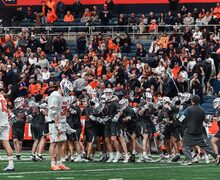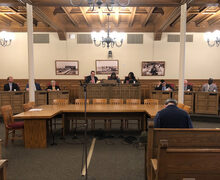‘We were all in a fog’: Syracuse beat Western Michigan hours after Pan Am Flight 103 tragedy
Courtesy of SU Athletics
Syracuse poses for a team photo. The 1988-89 SU team faced Western Michigan the day of the Pan Am tragedy.
The details of the night may fade, but what will stay with players is the silence. It was a deafening silence, a kind of silence that belied the cavernous Carrier Dome packed with 25,746 people. The facility carried a distressing tone. There were anguished sobs throughout the night. People had gathered to watch a Syracuse men’s basketball game on a cold day, Dec. 21, 1988. But it was almost an afterthought.
About six hours before tip-0ff, Pan Am Flight 103 exploded in the air over Lockerbie, Scotland. The terrorist attack resulted in the deaths of all 259 people aboard, including 35 SU students returning from study abroad trips and 11 people on the ground in Lockerbie. More United States civilians died in the bombing than in any other terrorist attack before 9/11.
Thirty years ago Friday, Syracuse, then No. 3 in the country, beat Western Michigan, 94-71. Only a couple of hundred feet away was a packed Hendricks Chapel mourning the deaths of SU students. Members of both teams recalled this month the confusion pregame, a mute crowd and the ensuing days full of sorrow.
“The whole community was grieving,” said Vernon Payne, Western Michigan’s head coach. “Students were in tears during the moment of silence. I think it was a moment the community, the cheerleaders and all players had a moment of realization of how tragic that loss was. We didn’t have a ‘let’s go play’ attitude. It was more of a, ‘We’ll have to play through this, guys.’”

Western Michigan’s 1988-89 team poses for a team photo. Courtesy of WMU Athletics
The decision to even play the game was met with criticism. A university vice president, Ron Cavanagh, received a phone call around 3 p.m. from a travel agent. He was told a plane had gone missing with Syracuse students on board. Cavanagh walked from one end of Tolley Hall to the other to meet with then-Chancellor Melvin Eggers. Their discussion centered on a decision: Should the game go on as scheduled?
Payne said his team would’ve been OK canceling the game. Syracuse head coach Jim Boeheim said he would’ve “thought long and hard about” whether to cancel, though the decision wasn’t up to him. Eggers decided to play the game because fans were driving from hours away and rapidly notifying people in the 1980s was a challenge in itself. It wasn’t clear what had happened to the plane yet. Eggers later said he regretted the decision.
A couple of hours before tip, Payne met with Boeheim and an SU Athletics representative and they discussed what had happened, what was known hours afterward and the possibility of canceling the game.
Meanwhile, Syracuse players arrived to the Carrier Dome around 6 p.m. Players said they entered individually and in small groups, and they asked one another: “What do you know? Did you have friends on the plane? Are we going to have a game?” They flipped channels on a TV outside the locker room to a local news station. Todd Blumen, then a student manager and current SU video coordinator, panicked. He thought his friend was on the plane. (He later learned his friend was not on the plane.)
Boeheim met with the team, but players said he didn’t address the tragedy. Everybody knew. He urged them to stay focused on the game so “we could get to our families for the holiday,” said Scott Goldman, a former student manager.
“It was pretty much chaos in the locker room,” Goldman said. “I would have desperately preferred to be at Hendricks with the rest of the community, grieving … During the game, I think everybody’s mind was someplace else.”

Catherine Hauschild hugs a fellow cheerleader and cries the day of the Pan Am tragedy. Courtesy of SU Archives
Western Michigan guard Mark Brown remembered the Broncos were excited to visit the Carrier Dome, which was eight years old at the time. They didn’t frequently play in large arenas. From watching SU games on TV, they knew how loud the place could get. And yet all Brown remembers is a noiseless place.
When players jogged to the court for warm-ups, the Dome began to fill. It wasn’t a sellout, but it was well attended. There were few students in attendance, players said, since many had either gone home for Winter Break or attended the vigil in Hendricks Chapel.
There was a commotion in the Dome during warmups, said Western Michigan guard Jerry Overstreet. Afterward, he saw people hugging and crying near the court. A coach had told WMU a tragic event impacted Syracuse, but the details were unknown. His mind raced during the game: “What happened?”
“During the game I thought, ‘Am I really here in this moment?’” Overstreet said. “The atmosphere was unbelievable. It was quiet, it was almost numbing.”
The game began at 8 p.m. Minutes before, Michael Rothermel, a Lutheran minister, held a microphone and told the crowd what was known. Spectators who weren’t previously aware of the news gasped. Rothermel said a prayer and called for a moment of silence. The Dome remained subdued the rest of the evening, with some fans leaving early. Student workers at concession stands considered leaving, too.
“There was panic pre-game,” said Syracuse starting guard Matt Roe. “It was an eerie environment. You began to question as a player, ‘Should we be playing this game?’ We were all in a fog.”
After the game, Marshall Street was quiet. Players from both teams prepared to go home for the holiday break. The game ended shortly before the vigil in Hendricks Chapel. People gathered and held burning candles on campus.
Payne, the WMU head coach, stayed a few days in Syracuse, where his wife’s uncle lived. They remained in Syracuse to grieve, and to heal, together.
“That never leaves you,” Payne said.
Published on December 21, 2018 at 10:42 am
Contact Matthew: mguti100@syr.edu | @MatthewGut21





